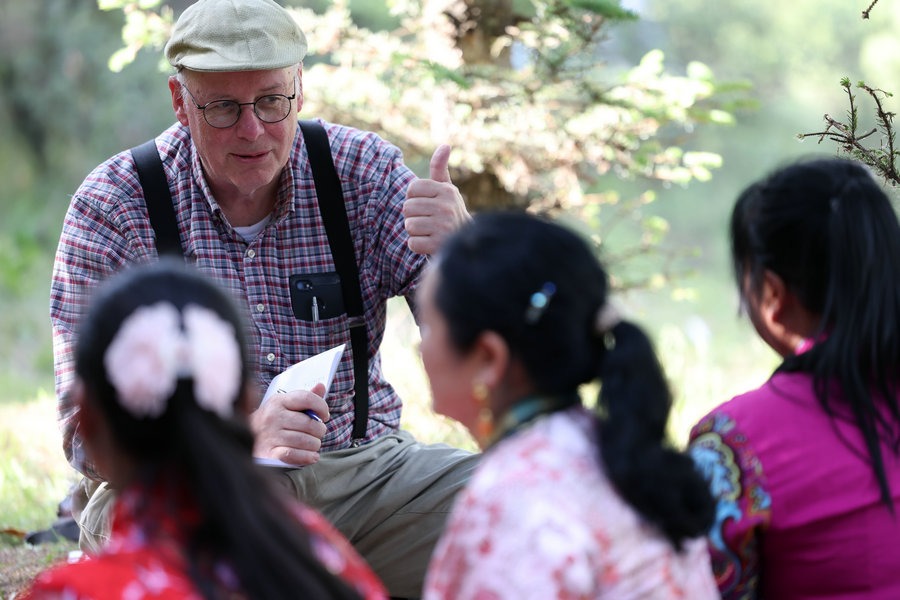Respecting and Protecting the Rights of All Ethnic Groups in Xinjiang

V. Social Rights
Xinjiang has established a social security system that covers all the local population. There has been a marked improvement in the region's capacity to provide health services and its response to public health emergencies. People can access social assistance in a timely manner. Reproductive rights for ethnic minorities are guaranteed.
Social security has been strengthened. A multi-layered basic social security system with wide coverage is now in place, including old-age insurance, medical insurance, work-related injury insurance, unemployment insurance, and subsistence allowances.
In 2011 Xinjiang took the lead in establishing basic old-age and medical insurance schemes that cover all local residents and bring urban and rural areas under unified management, realizing universal access to basic social security in the region. Poor people are guaranteed affordable medical services through basic medical insurance, serious illness insurance, and medical assistance.
Under the national plan to ensure universal access to social security, the actual coverage of basic old-age insurance for urban and rural residents in Xinjiang stands above 95 percent. Unemployment, work-related injury and maternity insurance schemes have been extended to cover all occupational groups. All poor people are now covered by basic medical, old-age and serious illness insurance.
As of 2020, 5.9 million people were covered by basic old-age insurance for urban employees, 7.3 million by basic old-age insurance for rural and non-working urban residents, 23.2 million by medical insurance, 3 million by unemployment insurance, and 3.5 million by work-related injury insurance. A total of 293,000 urban residents and nearly 1.7 million rural residents were in receipt of subsistence allowances.
In 2020, the average monthly subsistence allowance for urban residents increased to RMB 500 per capita, and the average annual subsistence allowance for rural residents increased to RMB 4,100 per capita, growing by more than 180 percent and almost 400 percent compared to 2010.
The basic pension benefits are adjusted as required. Retired enterprise employees have seen their pensions increase over the years, and their benefits in 2020 were 4.6 times higher than in 2005. In 2020, a total of RMB 9.4 billion was issued as relief fund to about 2 million needy people in both urban and rural areas.
Covid-19 has been effectively brought under control. Always prioritizing the health and safety of the people, Xinjiang has taken targeted measures to keep inbound and local transmission under control, and has adopted a science-based approach to treating patients.
It has provided universal access to free nucleic acid testing and vaccination. A monthly allowance of RMB 450 is provided to needy people who have no income or other sources of support due to the epidemic. Emergency relief funds have been established at the sub-district/township level to ensure timely response. Social assistance and subsistence allowances are adjusted when the Consumer Price Index fluctuates beyond a certain range, and temporary price subsidies are issued as required. In 2020, some 3.9 million victims of illness, natural disasters and the epidemic received RMB 2.1 billion of temporary relief subsidies.
Health services have been markedly improved. Health is an essential factor in leading a happy life. Putting people's health first, Xinjiang is taking measures to implement the Healthy China initiative, improve the health services network covering both urban and rural areas, and provide health services of higher quality.
As of 2019, Xinjiang had 18,376 medical institutions with 186,426 beds. There were 7.4 beds and 2.7 doctors per thousand people.
A health services network is now in place to serve communities in urban and rural areas. All township-level health centers and village clinics meet the required standards, and all villages have doctors. A public health information platform has been opened and local platforms across the region are managed and regulated in accordance with unified standards.
Telemedical services are available at all medical institutions at the county, prefecture, and autonomous region levels, and 85 percent of township and community health centers. Greater use of the internet is giving more people access to family doctors, to nursing services by online reservation, to medical consultation through video link, and to other new internet-based health services.
Fourteen forms of basic public health service are provided to urban and rural residents for free, covering almost the whole life cycle. A fund for health checkups was set up in 2016, into which RMB 8.2 billion has been injected to date, so that every resident in Xinjiang can have a free annual health checkup to spot early signs of illnesses. Major epidemics and endemics have been brought under control.
People with rural hukou (resident registration) can be admitted and receive treatment at any designated medical institution in counties, districts, cities, and prefectures before settling their bills, and the settlement is managed on a one-stop basis. This has made hospital trips more convenient and affordable. Major efforts have been made to pair up 56 hospitals in poor counties in Xinjiang with 63 leading hospitals in the region and other parts of the country, to step up medical services and hospital management in impoverished areas.
The people of Xinjiang now enjoy better health with improved health services. The average life expectancy grew from 30 years in 1949 to 74.7 years in 2019.
The reproductive rights of ethnic minorities are duly guaranteed. According to the Constitution and relevant laws, all citizens have reproductive rights and both husband and wife have the duty to practice family planning. Family planning is a basic national policy, with an emphasis on reproductive health, and prenatal, postnatal and early-life care. It has a direct bearing on gender equality, women's empowerment, poverty reduction, and sustainable development.
The application of family planning measures in China was gradually extended from coastal and inland to border regions, from urban to rural areas, and from the Han people to ethnic minorities. Preferential policies were implemented for ethnic minorities. In line with local conditions and in accordance with the state's laws and regulations, Xinjiang formulated its own family planning policies. Family planning was first applied to the Han people in the region in the early 1970s, but until the mid and late 1980s, ethnic minorities were not subject to this policy. The Measures on Family Planning released by the autonomous region in 1992 stipulated that urban Han residents could have one child per couple and those residing in rural and pastoral areas could have two, while for ethnic minorities, urban residents could have two children per couple and those in rural and pastoral areas could have three. Ethnic minority groups with relatively smaller populations were not required to follow the family planning policy. This was one of the major reasons why the ethnic minority populations in Xinjiang maintained a fast growth rate.
In parallel with the region's economic and social development, the different ethnic groups began to develop similar expectations in terms of family structure, so Xinjiang amended the Regulations on Population and Family Planning in 2017, introducing universal family planning policies for all ethnic groups: two children per couple for urban residents and three per couple for rural residents. In line with the national adjustments to laws and policies regarding population and family planning, Xinjiang will further modify and improve relevant local regulations and policies.


































